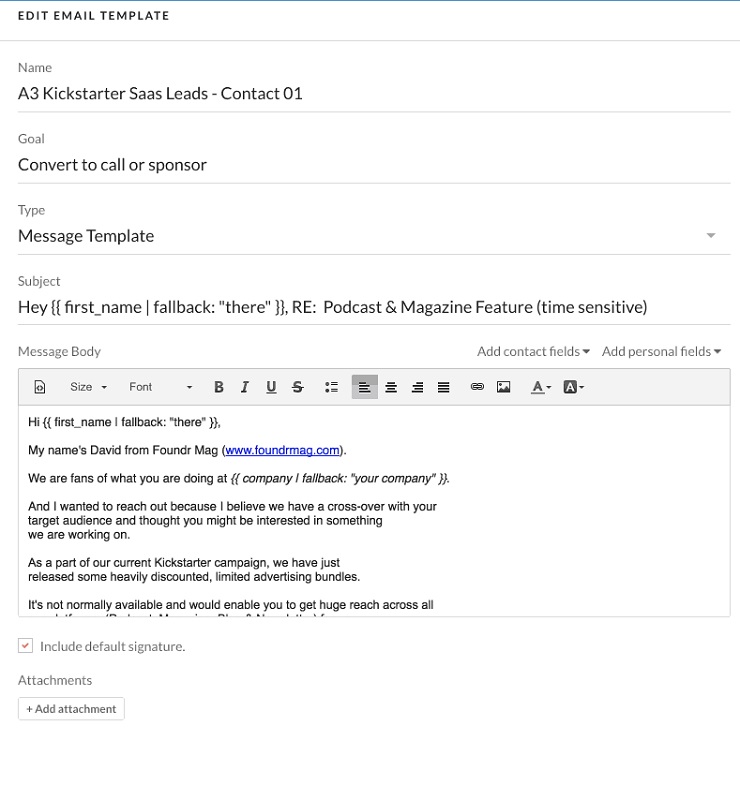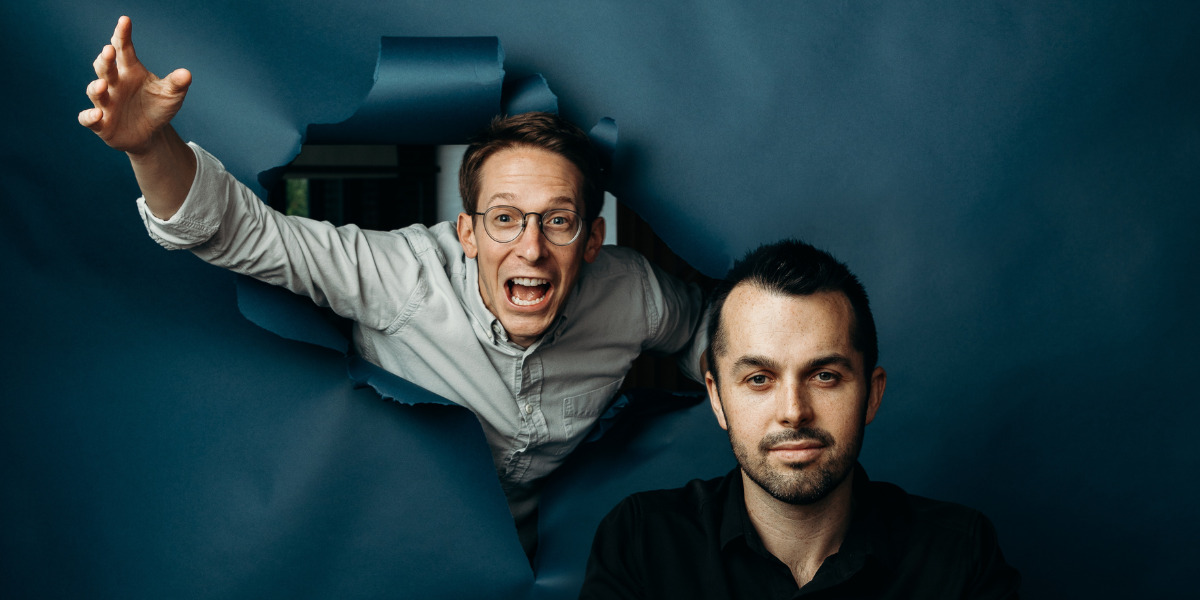Pulling in $50,000 in sponsorships alone in about a month. Can it be done? Sure.
But as the Foundr team and I set out to do just that, starting with a grand total of $0 mind you, I found myself facing down the barrel of the harder question:
How to get sponsored?
Now I’m sure there are some sales gurus out there who would laugh at this, and see $50,000 as “small money,” but if you’re anything like me, well I’m just a regular guy working in a fast-growth startup.
Pulling that kind of money out of thin air is a bit of a challenge. Also, making sponsorship deals can take a bit of time.
I first embarked on this task back when we were running our very first Kickstarter campaign, and selling our very first physical product, the Foundr V1.0 book. The campaign was already in motion, and I was stupid enough to say, “How can we get guaranteed backers, and not just hope people will buy our book?”
Definitely one meeting where I should have kept my mouth shut.
But at Foundr, we run fast and lean. We wanted to hit at least $200,000 for our first crowdfunding campaign in support of our book. And that is a crap-ton of books to sell.
Yes, we have a big brand and a killer audience of people like your good self, but to sell around 2,500 books on our first attempt, well, it’s far from guaranteed. This was back in the day when we were a baby company just learning to walk – we only had a small team of 10 remote-working staff members as opposed to today’s Foundr force of 30+ full-time employees across the globe.
But back in the day, this was not that easy.
I suggested that we should get proactive, make some deals, and try to guarantee some backers by offering something more than just books.
What if we could sell sponsorship packages on Kickstarter as high-priced perks to backers? That way we could increase funding and use an asset we already owned – attention.
We could offer brands or other entrepreneurs sponsorships, giving them some kind of exposure via our brand and campaign, in exchange for funding our project at a high level.
Nathan (our CEO) agreed on the spot and asked how much I thought we could pull in. No idea where we got the figure but we decided on $50,000.
And just like that, I was on the hook to pull in 50 grand, in addition to my day-to-day role at Foundr. That’s startup life.
So let’s break it down.
How to Get Sponsored in 4 Weeks
The Challenge
To raise $50,000 in 4 weeks (that’s $12,500 per week).
We were starting with:
- No deals
- No templates
- No offers
- No contracts
- No prospects
- No pipelines
The Result
In the end, we actually pulled in over $70,000 dollars in sponsorships, smashing our target with just a one-person sales team (unfortunately, not all of the money was able to go through the Kickstarter, but hey, money is money).
If you want to know how to get sponsored and rip money out of the air, ask strangers for money, and get a whole bunch of sponsorships…
I’ll walk you through what I did.
Here were the key elements:
- The offer (What could we offer in return for sponsorship money? i.e. what could we sell?)
- The prospects (Who might take up that offer?)
- The outreach (How could I get in touch with everyone in a short period of time?)
- The deal (Convincing people to sponsor us with cold hard cash)
The Offer
Everything in business is a transaction. It’s an exchange. And one thing that drives me crazy around Kickstarters and fundraising is what I call the “beggar mentality.”
You would have seen it. It’s where people say, “I want to raise money, please give me some.” It’s just fancy begging and not that different from rattling a tin can on the street.
It doesn’t matter how amazing your product, service, idea, or business is. You will repel people with this approach. You’re not offering value—or at least you are not communicating that value well to others.
So if you want to get people to give you money, whether that’s sponsorship or backing on Kickstarter, what’s the exchange? What are you going to do for them?
It’s also a far more powerful position to come from. You have something of value. When it’s limited or scarce you can use “prizing” to your benefit. Something I learned from Oren Klaff. It’s going to be much easier to generate interest and get sponsors and money if you have an attractive offer.
What could Foundr offer that had value to other people?
This is where the partnership triad kicks in, something I learned from Daniel Priestley. In every successful partnership, every business, even massive brands like Nike, have something that they need. It’s your job to find an intersection between what others need, and what you have.
For larger brands, a successful partnership might mean having money in the bank to pay for exposure via advertising. Others will need to leverage assets like the strength of their branding or audience. Or it could be something as simple as your expertise, or even having an office space people want to use. The idea is to look at what assets you have that would have value to others and help you get what you need.
In our case, we had an audience, but we needed money for our Kickstarter campaign. Our exchange would be simple: the audience for money. We decided to offer sponsorship packages including podcasts and magazine advertisements – something we don’t usually do.
Next, we made it compelling by pricing it very aggressively so that it was extremely competitive and excellent value. We knew that if someone wanted to advertise to startups and entrepreneurs, we could put them in front of our audience and as a bonus with a bit of an added halo effect from our brand.
How to Get Sponsored and Make This Work for You
If you want to know how to get sponsored, simply look at what you have that you can offer. Podcast advertising, social mentions, an e-mail broadcast to your subscribers, product reviews, creating content, products, expertise, member specials, workshops, and events. What can you offer, that has value to them? Think: branding, audience, information, opportunity
In the case of advertising or looking for sponsors, this will normally be specific reach and audience numbers.
Next, ensure your offer is extremely compelling and competitively priced. This makes it far easier for you to pitch and sell – even if you are not very good at sales. Add in extras and be ready to negotiate.
By the end of this stage, you should have an offer, in detail, that is well explained and well priced. What will your sponsor get for giving you their money?
It’s also a great idea to have more than one price point or offer. That way you can always negotiate down.
The Prospects
As we crafted our offer, we had a fairly good idea of who might take this up (hint: the best prospects are people who are already buying what you are going to offer).
Next, I worked with Charlotte, one of the amazing administrators on our team, to look at the top podcasts in our space, and find out which ones had advertising so we could look for highly qualified prospects to approach.
Charlotte created a list of who was already paying for advertising, and which podcasts they were advertising on. She then created a list of contacts and emails for those companies. There were only 10-20 prospects, and I knew we would need a bigger list. The question was, who would want to get in front of our audience and be a good match for our brand?
We quickly decided that SaaS companies and tools that were funded would a) be interested in growth, and b) have advertising budgets.
This was something I knew from my days working at ‘Elance’. A lot of companies have a great product, they have money for advertising, but they are looking for engaged audiences.
Charlotte used LinkedIn again and generated a pretty sexy list of about 200 potential companies I could reach out to.
Nothing fancy, just a spreadsheet. But pay attention, because things are about to get interesting. Make sure you have the fields “company name,” “first name,” “last name,” and “email” if you want to follow my methodology and marketing stack.
If you get very clear on your target customer/sponsor, it should be pretty easy to put together a list of people who are already paying for sponsorships, and also companies that might be interested.
The Outreach
Time to get our hands a little dirty. Now I’m not completely proud of what I did, but I do like how I did it. I needed to find a way to contact prospects and make them an offer, and the only way to do this is through good-ole-fashioned cold-calling.
No one likes cold-calling. No one likes cold-emails either, unless that email is highly targeted, compelling, and has something that they want.
Firstly, we need to contact 200 or so people. It needs to be a decent number because, like any sales or partnership funnel, out of that 200 maybe 40% open the email, 20% reply, and then 5-10% may actually end up becoming a partner.
Secondly, we need to give them an interesting, enticing message. You’re fishing for attention and you need some juicy bait to get some bites.
Now for a long-time, I have been using a secret weapon that is a little pricey but worth the money. I don’t even like sharing it here, but it’s a great tool. It’s called Contactually. It’s a CRM that integrates beautifully with Gmail, and it does a few things VERY well.
First, you can bulk and personalize emails. Cool right? That means you can send 200 emails in one click sent from your Gmail which is an absolute game-changer right there.
The heart of outreach at scale is that it needs to be personal, otherwise it will be ignored. People are always on the lookout for bulk messages, and they burn them on sight.
But an email that has their name, company, and email all referenced? Well, that’s a little more personal. That buys you a few extra seconds of their attention and at least will increase your chances that they’ll open it.
Second, Contactually shows you if the person you are emailing has received, opened, viewed, and clicked your email.
This is just pure gold.
.
You can set up follow-up emails so if anyone doesn’t open your email you can contact them. Be super careful not to be a pest or overly needy, you want to gently nudge them and not inundate them with aggressive emails.
Use this took to gauge whether people are interested or not. You can then start a follow-up sequence to continue to pitch the deal.
From here it’s a matter of writing compelling emails.
Most of the time I used something like:
The body of the email is crucial. It needs to be short, snappy, and not ask for too much. It’s important to pique curiosity but not give everything away. The goal is to simply to advance the conversation, not to land a deal.
The ask was just to get on a Zoom call to find out if we had an offer that would suit them, talk them through their needs, and see if we could help. I also used scarcity by limiting the number of sponsors we would take on.
That should be the goal of your outreach. Get an open. Get a response. Move the deal forward one step.
The Deal
When asking for $5,000+ from strangers, you are going to need to put in some face time. After using Contactually to follow up, the next step was to have a video call with them.
This can get messy. They were busy. I was busy. Time zones didn’t work, and remember I had about 200 people in the starting pipeline. Working in Australia and refusing to do midnight calls to Europe or the US seriously limited me.
Read More: 30 Expert Tips on How to Get 10k More Followers on Instagram
Again, this is where I had technology do the heavy lifting for me.
I used a brilliant scheduler called Calendly. It allowed me to easily have people book in a time with me (when I was free), add it to my calendar, send reminders, and even force them to pre-qualify by filling out a form. Just awesome. Highly recommended.
From there, I would talk to people on Zoom. Sometimes due to the time difference, I would be doing it from my car as I drove into work.
The best approach was to see it as a “partnership” and not a sales call.
The call structure was basically:
- Intro and pleasantries
- What do you guys do?
- What would help you (what do you need)?
- Here’s what we have (with good homework this should match what they need)
- The close (are you interested?)
Post call:
- Next steps (summarize the call on email)
- Reach an agreement and ask them to purchase via Kickstarter
There was no sneaky sales script. Being authentic works well, but you still need to ensure they understand the value of what you have and how that can help them.
So there you have it, simple!
Not necessarily easy. But it can be done.
Key Takeaways:
1. Do your research (have a great deal for the right person and it’s easy)
2. Use technology to leverage your time (I only spoke to about 10-15 qualified people)
3. Test, measure, refine and always focus on value
You will have something of value that other people want. Don’t beg for anything, put together a hot deal, and success is guaranteed.
Marketing Stack
Here’s a list of all of the SaaS tools I used and recommend if you need to find and close deals in a hurry.
- Finding Contacts: LinkedIn
- Acquiring Contact Details: Sellhack
- Listing Prospects: Google Sheets
- Contacting and Tracking: Contactually
- Automatic Scheduling: Calendly
- Videocalls and meetings: Zoom, GoogleMeets
Sponsorship FAQs
How do I get around gatekeepers?
Don't think about gatekeepers as a role to get around, but a tool to land a meeting. Whether they're a staff member or assistant, your first interaction with a gatekeeper will set the tone for your ask. So get to know them, ask questions, and be clear about your opportunity. Gatekeepers can do more than book a meeting. They can advocate on your behalf.
When should I stop asking for a sponsorship?
Use your best judgment reading the room or virtual room. A prospect might never say no to your face, but they will hint with verbal and non-verbal cues on whether you're pushing too much. In contrast, don't give up after one call. Instead, ensure you've answered all their questions and have thoroughly explained your value as a potential partner.
How long should my sponsorship pitch be?
Your pitch should only introduce your sponsorship opportunity. If you've already laid out the sponsorship value in an email, a verbal pitch should take at most 10 minutes. That can be done with a short slide deck, whitepaper, video, or drawn on a whiteboard. Then, leave plenty of time for your prospect to ask questions and discuss partnering in-depth.
Get Sponsored and Start Building
Learn how to get sponsored, close deals, or build your business with our all-access pass to courses, community, and more. Sign up for Foundr+.

























